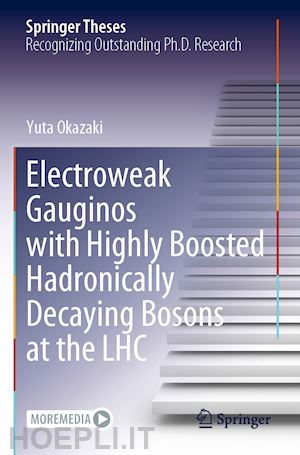
Questo prodotto usufruisce delle SPEDIZIONI GRATIS
selezionando l'opzione Corriere Veloce in fase di ordine.
Pagabile anche con Carta della cultura giovani e del merito, 18App Bonus Cultura e Carta del Docente
Supersymmetry (SUSY) introduces superpartners of the Standard Model (SM) particles. If their masses are typically O(100 GeV) ~ O(TeV), a lightest neutralino can be a candidate for the dark matter, and the problem is solved by canceling the correction of the Higgs boson mass. Further, SUSY can explain the experimental result of the muon magnetic moment (g-2).
This book presents a search for electroweakinos—the superpartners of the SM electroweak bosons—such as charginos and neutralinos using data at the LHC collected by the ATLAS detector. Pair-produced electroweakinos decay into the light ones and SM bosons (W/Z/h), and with the large mass difference between the heavy and light electroweakinos, the SM bosons have high momenta. In a fully hadronic final state, quarks decayed from the bosons are collimated, and can consequently be reconstructed as a single large-radius jet.
This search has three advantages. The first is a statistical benefit by large branching ratios of the SM bosons. The second is to use characteristic signatures—the mass and substructure—of jets to identify as the SM bosons. The last is a small dependency on the signal model by targeting all the SM bosons. Thanks to them, the sensitivity is significantly improved compared to the previous analyses.
Exclusion limits at the 95% confidence level on the heavy electroweakino mass parameter are set as a function of the light electroweakino mass parameter. They are set on wino or higgsino production models with various assumptions, such as the branching ratio of their decaying and the type of lightest SUSY particle. These limits are the most stringent limits. Besides, this book provides the most stringent constraints on SUSY scenarios motivated by the dark matter, the muon g-2 anomaly, and the naturalness.
Yuta Okazaki received the Bachelor of Science, Master of Science, and Ph.D degrees from Kyoto University in 2016, 2018, and 2022, respectively.
From September 2021, he is currently a researcher belonging to High Energy Accelerator Research Organization (KEK) in Japan. His research interests include the anomalous magnetic moment of muon and he works in the muon g-2/EDM groups to measure the nature of muon in J-PARC.
From April 2019 to September 2021, he was a recipient of the Research Fellowship of the Japan Society for the Promotion of Science. From April 2016 to September 2021, he worked as a collaboration member of the ATLAS experiment and searched for electroweak supersymmetric particles.











Il sito utilizza cookie ed altri strumenti di tracciamento che raccolgono informazioni dal dispositivo dell’utente. Oltre ai cookie tecnici ed analitici aggregati, strettamente necessari per il funzionamento di questo sito web, previo consenso dell’utente possono essere installati cookie di profilazione e marketing e cookie dei social media. Cliccando su “Accetto tutti i cookie” saranno attivate tutte le categorie di cookie. Per accettare solo deterninate categorie di cookie, cliccare invece su “Impostazioni cookie”. Chiudendo il banner o continuando a navigare saranno installati solo cookie tecnici. Per maggiori dettagli, consultare la Cookie Policy.